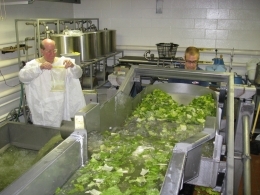
Name
Elliot Ryser, Ph.D.
Title
Professor
Institution
Michigan State University
Education
B.S., Biology, Carroll College, Waukesha, WI
B.S., Bacteriology, University of Wisconsin – Madison
M.S., Food Microbiology, University of Wisconsin – Madison
Ph.D., Food Safety, University of Wisconsin – Madison
What influenced you to work in food safety?
My major professor said years ago nothing else matters - quality, texture, taste - if the food kills you. At the University of Wisconsin, I took my first food microbiology course with Dr. Robert H. Deibel, a legend in the field of microbiology who founded Deibel Labs. However, my true mentor was Dr. Elmer H. Marth under whom I earned my master’s and doctoral degrees.
How did you learn about CPS?
I learned about the Center for Produce Safety on Doug Powell’s website.
CPS has funded “Impact of organic load on sanitizer efficacy and recovery of Escherichia coli O157:H7 during commercial lettuce processing.” Can you go over the project objectives? Any updates?
The objectives were to quantify the impact of organic load and efficacy of a chlorine-based sanitizer against E. coli O157:H7 in a model bench-top system and in a pilot-scale processing line for leafy greens at Michigan State University. Sanitizers are added to water in the flume tank to minimize cross- contamination of product during washing. Overall, the sanitizer has little effect on the product with microbial populations generally decreasing only 90 to 99%. However, these same chlorine-based sanitizers are rapidly inactivated by organic material in the water. During an 8 hour production period, you get a tremendous build up in the water just from processing. Eventually, the water will turn green with the organic load reaching as high as 10% in some commercial operations. This high level of organic load negates the efficacy of chlorine. The project is moving along nicely. Some of our findings were presented at the annual meeting of the International Association for Food Protection this past summer in Milwaukee, Wisconsin.
What do you think the industry will gain from your research project?
The industry will gain a clearer understanding of how the buildup in organic load impacts the efficacy of chlorine-based sanitizers and the activation of E. coli and other microorganisms. In addition, several very simple and rapid tests are being developed for routine monitoring of the organic load in the wash water. These new tests will likely be useful in maintaining sanitizer efficacy during commercial processing of leafy greens.
Can you tell us about the technology used in the pilot plant?
One element of the pilot plant is a commercial size lettuce shredder manufactured by Urschel Laboratories. Heads of lettuce are shredded and dropped on to a step conveyor. The conveyer takes the lettuce to a flume tank for washing. A screen is installed at the far end of the flume tank to retain the product during washing. We can hold the product for any length of time we choose. After the screen is raised the product enters the shaker table for partial de-watering. From there the product is collected in baskets and centrifugally dried. To my knowledge, Michigan State University is the only university in the country that has a pilot plant processing line of this type for leafy greens. The industry continues to show considerable interest in our work.
Where do you see food safety in five years down the road?
We are all concerned with the safety of fresh produce. The issue came to the nation’s attention with the 2006 spinach and lettuce outbreak followed by concerns with tomatoes and jalapeno peppers. Most recently, cantaloupe was involved in a multi-state outbreak of listeriosis. Consequently, we expect to look at the pathogen transfer during the slicing and dicing of these and other products over the next four years.
What are key factors influencing this field of inquiry?
This field of study is being fueled by the reports of outbreaks traced to consumption of fresh fruits and vegetables.
What does a normal day consist of?
I teach a course entitled Food Safety and HACCP three days a week and I have my research program to contend with. At present, I supervise seven graduate students and their research projects. Every other year I teach a course entitled Foodborne Diseases for graduate students. I am also one of four scientific co-editors for the Journal of Food Protection.
What are your interests?
My current interests are focused on pathogen transfer during food production. We have done a lot of work previously on transfer of L. monocytogenes during mechanical slicing of delicatessen meats. That has led into the current work on E. coli O157:H7 transfer during production of fresh cut leafy greens. Expanding on our current work, we received a USDA grant to look at pathogen transfer during slicing and dicing of different fruits and vegetables.
Please describe one or more of your career highlights.
One highlight is the work we did with Listeria transfer during the slicing of delicatessen meat. This was in response to several major outbreaks with delicatessen turkey meats in 2002. We were able to show that about 90% of the Listeria population transferred during the first ten slices. We were also involved in a large-scale survey of delicatessen meats. Through our findings we know deli meats sliced at a delicatessen are seven times more likely to be contaminated than sliced product that comes directly from the processor. These findings have been used in risk assessments by USDA, not only for deli meats but also for other products such as smoked salmon.